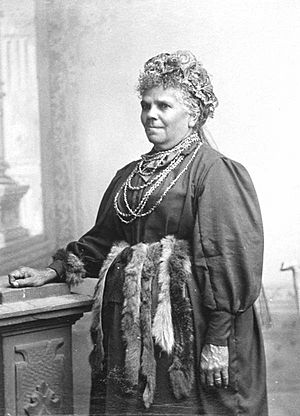Fanny Cochrane Smith facts for kids
Quick facts for kids
Fanny Cochrane Smith
|
|
|---|---|
 |
|
| Born | December 1834 Settlement Point (or Wybalenna, meaning Black Man's House) on Flinders Island, Tasmania, Australia
|
| Died | 24 February 1905 (aged 70) Port Cygnet, Tasmania, Australia
|
| Spouse(s) | William Smith |
| Children | 11 |
Fanny Cochrane Smith (born December 1834 – died 24 February 1905) was an important Aboriginal Tasmanian woman. She is known as the last fluent speaker of a Tasmanian language. Her special wax cylinder recordings of songs are the only audio recordings of any of Tasmania's native languages. In 2017, her recordings were added to the UNESCO Australian Memory of the World Register. This register lists important documents and recordings from history.
Early Life and Education
Fanny Cochrane was born in December 1834 on Flinders Island, Tasmania. Her birthplace was called Settlement Point, also known as Wybalenna, which means "Black Man's House." Her mother, Tanganutura, was one of the Aboriginal Tasmanians moved to Flinders Island in the 1830s.
When Fanny was five years old, she went to live with Robert Clark, a preacher at Wybalenna. She stayed with him until she was eight. After that, she was sent to an orphan school in Hobart. There, she learned skills for domestic service, like cooking and cleaning. She later returned to Wybalenna and worked as Clark's servant until 1847. In 1847, her parents and other survivors from Wybalenna were moved to Oyster Cove.
Family Life
In 1854, Fanny married William Smith, who was an English sawyer (someone who cuts timber) and a former convict. They had a large family, with 11 children born between 1855 and 1880.
After they got married, Fanny and William ran a boarding-house in Hobart. The government later gave Fanny some money each year and a piece of land. She chose land near Oyster Cove so she could be close to her mother, sister, and brother. The family moved there before their first child was born. They grew their own food, but they earned money by cutting and selling timber.
Later Years and Legacy
After another important Aboriginal Tasmanian woman, Truganini, passed away in 1876, Fanny Cochrane Smith became known as "the last Tasmanian." There was some discussion about whether she or Truganini was truly the last full-blood Tasmanian Aboriginal person. However, in 1889, the government of Tasmania gave Fanny more land and increased her yearly payment.
Fanny became a Methodist and donated land to build a Methodist church. This church was located at Nicholls Rivulet and opened in 1901. Fanny Cochrane Smith died on 24 February 1905, from pneumonia and pleurisy. She passed away in Port Cygnet, which was about 10 miles (16 km) from Oyster Cove.
Fanny Cochrane Smith is most famous for her wax cylinder recordings of Aboriginal songs. These recordings were made in 1899. They are the only audio recordings that exist of an indigenous Tasmanian language. Five cylinders were originally made. However, by 1949, only four remained, as one cylinder with the song translations was broken. It is said that when Fanny heard her own voice on the recording, she cried, thinking it was her mother's voice.
In 1998, Australian folk singer Bruce Watson wrote a song about the recording of Fanny's songs. The song is called The Man and the Woman and the Edison Phonograph. Bruce Watson is the great-grandson of Horace Watson, who made the recordings in 1903. A photograph of Fanny Cochrane Smith and Horace Watson can be seen at the National Museum of Australia.
See also
 In Spanish: Fanny Cochrane Smith para niños
In Spanish: Fanny Cochrane Smith para niños

